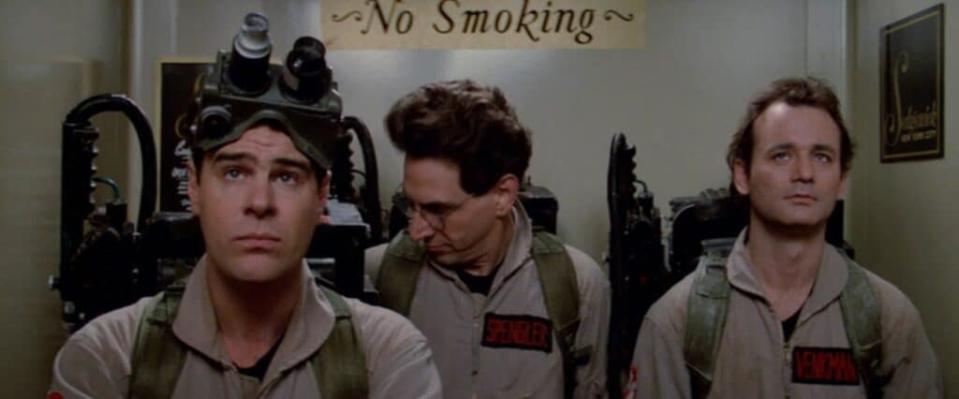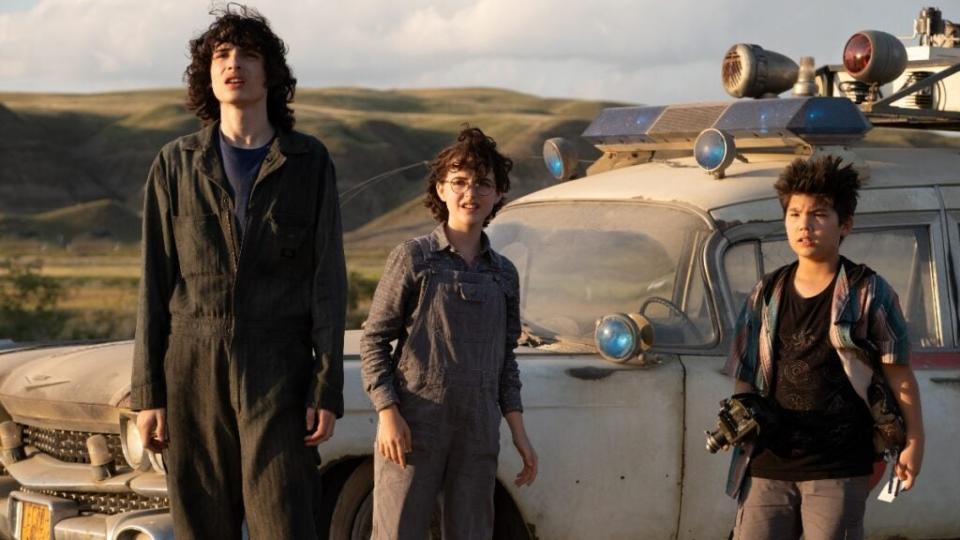‘Ghostbusters: Afterlife:’ How Egon Was Brought Back Through Cutting Edge VFX
- Oops!Something went wrong.Please try again later.
- Oops!Something went wrong.Please try again later.
- Oops!Something went wrong.Please try again later.
- Oops!Something went wrong.Please try again later.
- Oops!Something went wrong.Please try again later.
(Warning: This post features major spoilers for “Ghostbusters: Afterlife”.)
“Ghostbusters: Afterlife” is the kind of big popcorn movie that is gloriously stuffed with eye-popping visuals – a gluttonous phantasm (with the voice of Josh Gad) careens through a small town; an army of teensy, vicious Stay Puft Marshmallow men wreaks havoc in a Walmart; an undead deity rises from the fiery underworld.
But its most dazzling moment is a much quieter, more impactful one, as the ghost of Egon Spengler rejoins his family (played by Carrie Coon, Mckenna Grace and Finn Wolfhard) and fellow Ghostbusters (Bill Murray, Dan Aykroyd and Ernie Hudson) for a final showdown against evil. Of course, what makes this so miraculous is that Harold Ramis, who played Egon Spengler in the first two “Ghostbusters” films (and also co-wrote them) died in 2014.
“It’s a Movie That Ends With a Hug”

According to co-writer/director Jason Reitman (son of original “Ghostbusters” director Ivan Reitman), he always had the ending of “Ghostbusters: Afterlife” in mind.
“You don’t know you’re going to make a movie when you know the beginning of the movie. You know you’re going to make a movie when, you know the end of the movie. That seems like a simple thing to say, but I think it’s actually really important. All of us come up with the ideas for beginnings of movies,” Reitman explained. “But I knew I was going to make ‘Up in The Air’ once I knew the end of the movie and ‘Ghostbusters: Afterlife,’ which I thought I would never make. I knew I needed to once I knew the ending.”
What’s unique, too, is that the movie doesn’t end with a giant goliath towering over our heroes; even the Stay Puft Marshmallow man is tiny in “Ghostbusters: Afterlife.”
“This is a movie that doesn’t end with an explosion,” Reitman said. “It’s a movie that ends with a hug.”
But it was more than just a hug – it was combining the thematic and emotional threads of the movie into one powerful moment.
“The idea was about generational forgiveness and being able to say goodbye and to accomplish that, we were going to have to create an impossible moment on screen, a moment in which the four Ghostbusters stand next to each other one last time, a moment in which the original Ghostbusters get to say goodbye to Egon, who was my favorite Ghostbuster,” Reitman said. “And a moment in which a granddaughter gets to meet her grandfather for the first time and a woman gets to forgive and embrace her father.”
It’s just that this movie-ending hug turned out to be just as difficult and time consuming as any spaceship exploding, requiring artists and technicians in a variety of disciplines to come together with the same singular goal: to bring Egon, a character defined by his relationship with the paranormal, back from beyond the grave.
A Supernatural Stand-In

When production began on “Ghostbusters: Afterlife” in the summer of 2019 they already had an Egon. Sort of. Reitman hired Bob Gunton, the talented, 76-year-old character actor perhaps best known as the sadistic warden from “The Shawshank Redemption,” as the on-set Egon.
“He’s this brilliant actor who came and performed the scene with the original guys, and he had to do the selfless thing of agreeing to be a part of a movie that you would never see him in,” Reitman said. (He also appears in the movie’s cold open, which establishes Egon’s demise and his existence as a shut-in in the middle of nowhere Oklahoma.) Harold Ramis’ version of the character hadn’t returned. Egon remained trapped in the foggy ether between worlds. Still – it was a start.
Visual Effects Wizardry
By Reitman’s estimation, the process of returning Egon took two years. The visual effects house tasked with the job was London-based MPC, who also started on the project in the summer of 2019.
Perhaps best known for their work on Jon Favreau’s “The Lion King” and “The Jungle Book,” MPC had also convincingly brought 1982 Sean Young back using a similar process for 2017’s “Blade Runner 2049.” Reitman calls the “Blade Runner 2049” version of Rachel “in my opinion is best virtual character ever done.” If they could do it once, they could do it again.
“I basically made a little schedule, another plan for if we needed to do another reproduction of an actor from the mid-1980s. What would that process entail?” Dan Zelcs, MPC film character supervisor for “Ghostbusters: Afterlife,” said.
Zelcs was part of a team called MPC Character Lab, who have worked on everything from digital humans like this (they also did the circa-1991 Arnold Schwarzenegger from “Terminator: Dark Fate”) to characters like Pikachu and Godzilla. “I knew what the project was meant to be for, but the specifics were still under wraps and it wasn’t until a bit later on that we got the project awarded that we saw the artwork and we knew exactly what the target was,” Zelcs said.
Zelcs created a “checkpoint” for along the way – they were going to create a younger, photoreal version of Harold Ramis as he appeared in the original film.
“They created a younger version of Harold and actually edited him into the 1984 ‘Ghostbusters’ to prove that they could do it, so that you would watch the movie and not know whether you were watching a virtual Harold or the original Harold from the film,” Reitman said.
The goal was simple and daunting.
“We wanted to make sure we could match the original. Match his likeness, match his poses, match his hair, match his glasses. We were even looking at like trying to figure out the prescription of the glass,” Zelcs said. The visual effects identified scenes from the original film that the digital Ramis could be easily dropped into. “There was one that was particularly successful and we sent it as just an insert of him, and just as a proof of concept that we could match original Egon,” Zelcs said.
They sent it to Reitman, who was shooting in Canada. “We would be on set, reviewing footage from 1984 Ghostbusters,” Reitman said. It was seamless. The impossible was achieved. Almost.
“They took the young version of Harold that they had created and then slowly aged him to the age that he would’ve been in the movie,” Reitman said. MPC used the footage featuring Gunton as a start. “From the neck down, it’s him,” Zelcs said. They also utilized a scan of Gunton, looking at the facial muscles, the wrinkles and folds, the “tics and squints” that made his skin believable.
Zelcs and the MPC team ran into an unexpected roadblock: Egon’s hair. “His hair took a long time to get right,” Zelcs said.
“We got the Harold hair from the 1984 film. It was more about we were given a concept image of what they were aiming for, but it was a hand painted image. It was ambiguous.” They wanted it to be reminiscent of the original Egon hairstyle, but it still had to evolve. “We wanted him to feel older and a bit wilder, because he’s been living in the farm for so long. It had to be reminiscent of what the actor would be like at that age as well, but it was very much steered towards it needs to be Egon at that age.”
Another aspect the MPC team wrestled with: just how ghostly to make him. (In the final film he’s classically ghost-like – glowing and semi-transparent.)
“It was part of our task to refine the look. It’s funny looking back at how they did the ghost effect in the 80s where it was filmed a separate element with different lighting, and then multiplied against a plate. There is also like a roughness to it, whereas with this, you want to see the detail,” Zelcs said. “You don’t want to hide too much behind a ghost effect.”
In other words, this new Egon had to stand on his own. “We were building it the best it could be and then however the final effect applied on top was decided, that would only add to it. It wouldn’t be disguising what we’ve done,” Zelcs said. Somehow the effect, glittery and ethereal, adds to the emotionality of the scene and of Egon’s return.
The Ultimate Seal of Approval

Bringing Egon back was undoubtedly the biggest filmmaking challenge of “Ghostbusters: Afterlife.” But Reitman knew it would work relatively early. “Of the many things that terrified me about making this film, this was at the top of the list,” Reitman said. “And the first time I saw young Harold, I knew they were going to be able to do it. What they do is magic.”
MPC knew they had pulled off the magic trick when the Ramis family gave their seal of approval. “The fact that it moved them, it was very gratifying, and it was also very moving for us. You realize that what you’re doing, it’s a pretty raw thing to be doing,” Zelcs said. “It felt like we’d done it respectfully and we’d done it with the approval of those that were important.”
According to Reitman the Ramis family, particularly Erica Ramis (Harold’s wife) and Violet Ramis (his daughter), were involved in the film’s production throughout. They were the first people, after Jason’s father, to read the script. And they stuck around.
“They’ve been a part of this process the whole way. They read the script, they came to set, they came to the editing room, they reviewed the final version of the movie. I was never going to make this movie without them,” Reitman said. “The extraordinary experience has been getting to know them better, getting to know these people that have known since I was a kid, even better as they entrusted me with these scenes.” Reitman credits Gunton’s performance, and the reactions of the rest of the actors. “I don’t know what it’s like to perform a scene where you are simultaneously saying goodbye to a character, but saying goodbye to someone you also loved in real life,” Reitman said.
There was one moment that resonated the most with Reitman, and to those who saw early versions of the sequence.
“Egon looks at his daughter and he has this look in his eyes like I tried. And that was the shot,” Reitman remembered. “We showed it to a few people in editing and all you had to do was look at that one shot and it broke your heart.”
All of that hard work had paid off. The filmmakers and visual effects artists and technicians had brought a legendary actor back to the big screen, in a way that nobody had ever seen him before but one that felt perfectly in tune with the other performances. “Ghostbusters: Afterlife” showcases the rarest type of visual effect, the one that makes you feel. Talk about special.

